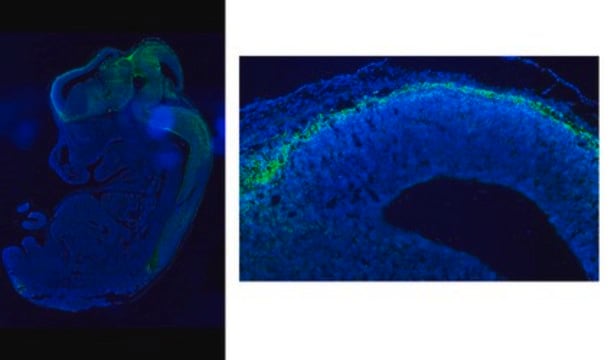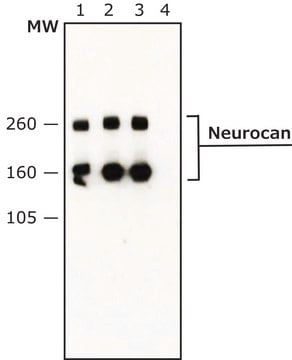推荐产品
生物来源
mouse
质量水平
抗体形式
purified immunoglobulin
抗体产品类型
primary antibodies
克隆
650.24, monoclonal
种属反应性
rat
制造商/商品名称
Chemicon®
技术
immunocytochemistry: suitable
immunohistochemistry: suitable
immunoprecipitation (IP): suitable
western blot: suitable
同位素/亚型
IgG1
NCBI登记号
UniProt登记号
运输
wet ice
靶向翻译后修饰
unmodified
基因信息
human ... NCAN(1463)
一般描述
神经蛋白聚糖(Neurocan)是大脑中主要的可溶性硫酸软骨素蛋白聚糖。它被认为在胚胎脑发育过程过程中轴突生长和导向以及特定神经通路的建立中起一定功能。神经蛋白聚糖在大脑中的表达受发育调节。神经蛋白聚糖的早期主要形式包含一个245 kD的核心蛋白,大约两条硫酸软骨素糖胺聚糖链(每条22 kD)。较晚期的神经蛋白聚糖包含一个180 kD 的核心蛋白。两种形式的神经蛋白聚糖仅含有硫酸软骨素4 糖胺聚糖链。通过其在神经损伤和创伤位点的高表达,硫酸软骨素蛋白聚糖(包括神经蛋白聚糖)被认为可抑制神经再生。5
特异性
神经蛋白聚糖克隆650.24的特异性已通过脑裂解液和纯化神经蛋白聚糖的蛋白质印迹进行检验。该抗体发生反应的条带与克隆1D1 和1F6(其它神经蛋白聚糖单克隆)反应的条带相同。此外,脑切片的染色模式与这些抗体都相同。最后,通过蛋白质印迹法,650.24 也识别在转染293细胞中表达的重组神经蛋白聚糖。
免疫原
胚胎大鼠脑蛋白聚糖。
应用
研究子类别
神经退行性医学
生长锥细胞 & 轴突导向
研究类别
神经科学
神经科学
蛋白质印迹:1-2 μg/mL。在胚胎大鼠脑组织提取物的蛋白质印迹中,与分子量260 和 160 kDa的多肽反应。160 kDa蛋白通常仅在软骨素酶处理后出现。软骨素酶溶于Tris-HCL(pH 8.0),处理浓度是10U/m。 在蛋白酶抑制剂存在的情况下,将组织或细胞提取物溶解在含0.15M NaCl的 20-50mM Tris (pH 7.6-8.0)中。 每30微升提取物加入1 微升酶,并在37C下培养30分钟。 然后添加SDS样品缓冲液,以SDS还原样品的正常条件加热或煮沸样品。
免疫细胞化学:1:5
4% 多聚甲醛固定组织的免疫组化:1:1,000
免疫沉淀:1:2 μg/mL。
最终工作稀释度必须由最终用户确定。
免疫细胞化学:1:5
4% 多聚甲醛固定组织的免疫组化:1:1,000
免疫沉淀:1:2 μg/mL。
最终工作稀释度必须由最终用户确定。
该抗神经蛋白聚糖抗体(克隆650.24 )经验证可用于IP、WB、IC、IH中的神经蛋白聚糖检测。
外形
形式:纯化
纯化的免疫球蛋白。 0.02M磷酸盐缓冲液,0.25M NaCl和0.1%叠氮化钠的液体。
储存及稳定性
以未稀释的等分试样保存于2-8°C下6个月。
分析说明
对照
阳性对照:
早期产后大鼠脑在肾脏、肺、肝脏或肌肉中不表达。
阳性对照:
早期产后大鼠脑在肾脏、肺、肝脏或肌肉中不表达。
其他说明
浓度:请参考批次特异性浓缩物的检验报告。
法律信息
CHEMICON is a registered trademark of Merck KGaA, Darmstadt, Germany
免责声明
除非我们的产品目录或产品附带的其他公司文档另有说明,否则我们的产品仅供研究使用,不得用于任何其他目的,包括但不限于未经授权的商业用途、体外诊断用途、离体或体内治疗用途或任何类型的消费或应用于人类或动物。
未找到合适的产品?
试试我们的产品选型工具.
储存分类代码
10 - Combustible liquids
WGK
WGK 2
闪点(°F)
Not applicable
闪点(°C)
Not applicable
Frauke Seehusen et al.
PloS one, 11(7), e0159752-e0159752 (2016-07-22)
In demyelinating diseases, changes in the quality and quantity of the extracellular matrix (ECM) may contribute to demyelination and failure of myelin repair and axonal sprouting, especially in chronic lesions. To characterize changes in the ECM in canine distemper demyelinating
James M Massey et al.
Experimental neurology, 209(2), 426-445 (2007-06-02)
Increased chondroitin sulfate proteoglycan (CSPG) expression in the vicinity of a spinal cord injury (SCI) is a primary participant in axonal regeneration failure. However, the presence of similar increases of CSPG expression in denervated synaptic targets well away from the
Alterations in chondroitin sulfate proteoglycan expression occur both at and far from the site of spinal contusion injury.
Andrews, EM; Richards, RJ; Yin, FQ; Viapiano, MS; Jakeman, LB
Experimental neurology null
Marc R Del Bigio et al.
Cerebrospinal fluid research, 5, 12-12 (2008-07-12)
The cerebral cortex may be compressed in hydrocephalus and some experiments suggest that movement of extracellular substances through the cortex is impaired. We hypothesized that the extracellular compartment is reduced in size and that the composition of the extracellular compartment
Wu-Fu Chen et al.
CNS neuroscience & therapeutics, 21(9), 698-707 (2015-07-21)
To date, no reliable methods have proven effective for treating spinal cord injury (SCI). Even systemic administration of methylprednisolone (MP) remains controversial. We previously reported that intrathecal (i.t.) administration of granulocyte colony-stimulating factor (G-CSF) improves outcome after experimental spinal cord
我们的科学家团队拥有各种研究领域经验,包括生命科学、材料科学、化学合成、色谱、分析及许多其他领域.
联系技术服务部门








